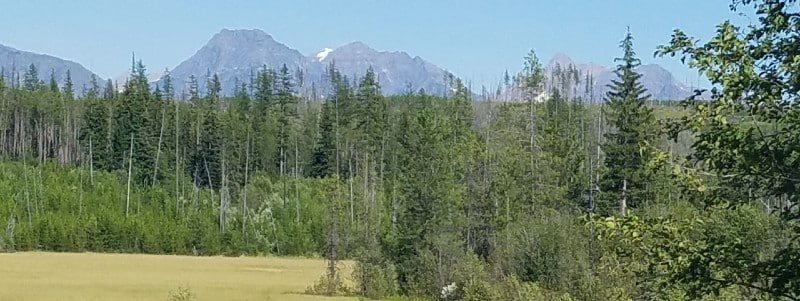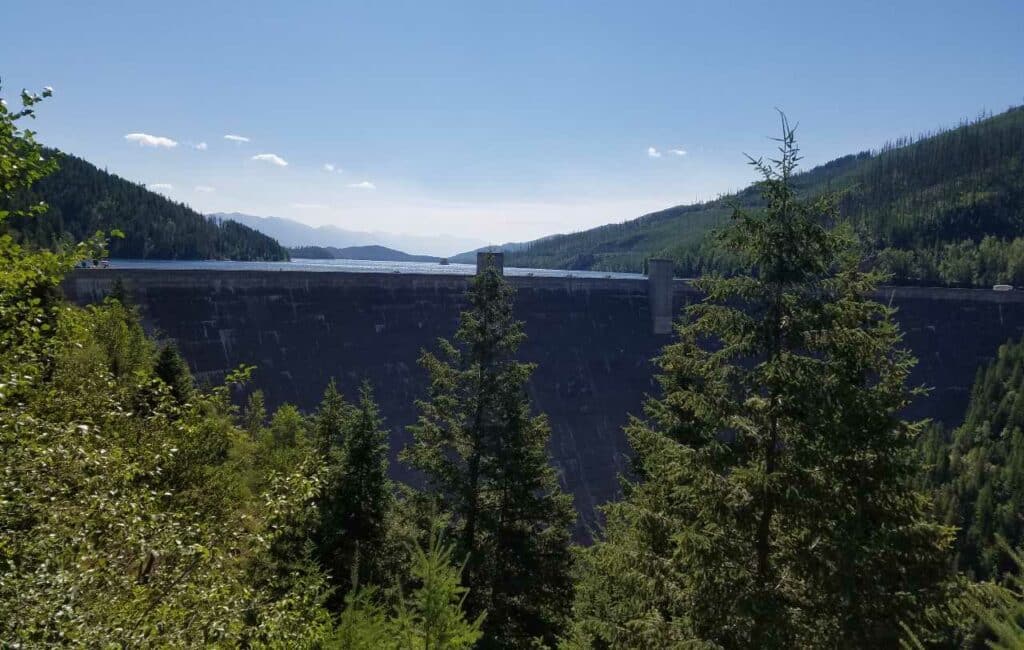Planning For A Triathlon At Higher Altitude

How can you prepare for racing in a triathlon or other multisport endurance event that is at a significantly higher altitude than where you live and train?
While crossing the USA to complete a triathlon in every state, I have raced in western states, where the altitude on the courses was between 4,000 and 7,000 feet above sea level. Having trained in areas well below this, between sea level and 1,000 feet, I felt the effect of the altitude on race day.
Related post: Triathlon Across the USA: State #22 – New Mexico

What Happens When We Travel to Higher Altitude
As pictured in the chart below, the most important change is that the amount of oxygen in the air effectively decreases with altitude.
The people at APEX (Altitude Physiology Expeditions) describe it like this:
“At real altitude (in the mountains), the barometric pressure of the atmosphere is much lower than sea-level environments. The result is that oxygen molecules are spread further apart, lowering the oxygen content of each breath.”
While each air molecule contains the same amount of oxygen no matter the elevation, the density of air molecules decreases with altitude. This effectively reduces the oxygen content.
In other words, we draw in fewer air molecules with each breath at high altitude compared to a lower one. Each breath provides less oxygen for our muscles to burn fuel and create the power to move us through the water or along the road.
The result is that for a particular rate of perceived exertion (RPE), we will have less oxygen with which to power our muscles. We aren’t able to swim, bike, or run as fast as we are with more oxygen.

How I Selected the Altitude Range For The Graph
The 106° West Triathlon, first (and apparently only) held in 2016, was touted as the ‘Highest Triathlon in the World’ held at an elevation of 9,156 feet (2,791 meters). This race included quarter and half distances of the IRONMAN 140.6.
Let me know in the Comments (below) of any triathlons held at an altitude higher than this one.
Dealing With Altitude: Acclimatization and Adaptation
Two words – acclimatization and adaptation – are used to describe what happens when we travel to a higher altitude.
Acclimatization
Acclimatization refers to the immediate and short term (up to two weeks) changes that occur with altitude.
This process begins immediately upon arriving at the higher altitude. The effect we recognize as breathing harder is called ‘respiratory alkalosis’.
Within a day, the hemoglobin concentration increases. We do not have more red blood cells at this point. However, the liquid component of our blood, the plasma, decreases to normalize the oxygen content in our blood. Lower oxygen content divided by lower plasma volume equals normal oxygen concentration (but not volume) in the blood.
Acclimatization continues over about two to three weeks.
Adaptation
Adaptation describes the longer-term effects, ones that take place over several months.
With extended time at altitude, our body will produce additional red blood cells through the production of the erythropoietin (EPO) hormone. Increasing the number of red blood cells increases the amount of oxygen available to our muscles and other organs.
It takes months, typically eight months according to what I have read, for the body to produce all the additional red blood cells and for adaptation to be complete.
‘Sleep High, Train Low’
There is evidence that the ideal adaptation comes from sleeping at high altitude (between 6,600 and 8,200 feet, which is equal to 2,000 and 2,500 meters) and training at or near sea level.
Sleeping high leads to an increase in hemoglobin. Training low allows for more intense training to increase the key parameter for endurance, VO2max.
How Does Age Affect These Changes?
As seniors in the multi-sport community, we know that age changes the way we train compared with our younger competitors. But, does altitude give us an advantage or create a disadvantage on race day?
Altitude may be one of the few factors that are on our side. According to a report titled Effect of High-Altitude Exposure in the Elderly, age does not seem to be a factor in adjusting to the higher elevation. According to the authors of this study:
“Fortunately, the elderly appear to acclimatize well and after 5 days of acclimatization were physiologically almost indistinguishable from sea level. Thus, aging does not appear to impair the physiological adaptive response to either acute or chronic hypoxia, even in the presence of substantial comorbidity.”

What Can You Do To Prepare For A Triathlon At Higher Altitude?
The audience for this post is beginner and intermediate age group athletes. Therefore, I am assuming you will not invest the time and money for training at an altitude camp for several weeks.
However, even if you do, there is no guarantee of increased performance, according to many coaches and scientists. Some people do not adapt. And, the training must be tailored to the individual for it to have significant benefit. (Continue reading for more information on high altitude training.)
Nevertheless, there are ways you can prepare for a triathlon at a higher altitude.
1. Arrive at the race altitude from 2 to 14 days before the race
In a paper titled “Timing of Arrival and Pre-acclimatization Strategies for the Endurance Athlete Competing at Moderate to High Altitudes”, authors Robert F. Chapman, Abigail S. Laymon, and Benjamin D. Levine (see the complete reference in the quotation below) conclude that arriving at the race altitude 14 days before the event is the most ideal. However, they also acknowledge that this amount of time will not be practical for most, given the cost and other responsibilities related to family and work.
Arriving the night before the competition, on the other hand, is a risky strategy. This is especially true if you suffer from any disruption in sleep, a critical component of acclimatization.
While longer is better, 2 to 14 days before the race at the altitude of the event reduces performance declines. This comes from settling into a consistent pattern of quality sleep and reducing the deleterious physiological effects of altitude, such as a reduction in plasma volume.
Performance decrement at altitude appears to decline with each day of altitude residence (up to ~14 days).
Chapman, Robert F., Abigail S. Laymon, and Benjamin D. Levine, “Timing of Arrival and Pre-acclimatization Strategies for the Endurance Athlete Competing at Moderate to High Altitudes”, High Altitude Medicine & Biology, Volume 14, Number 4, 2013, pp. 319-324.

2. Pay extra attention to factors that degrade at altitude
This is in line with the previous point, but worth repeating.
First, stay hydrated. Along with lower effective oxygen, higher altitude also means lower relative humidity of the air. Therefore, fluid loss is greater than in higher humidity regions.
Also, the higher altitude may compromise your sleep. According to this TrainingPeaks article, getting sleep during the initial time at higher altitude can be difficult for some. Some people initially suffer from acute mountain sickness (AMS). Symptoms of AMS include headaches, nausea, dizziness, and fatigue.
Give yourself time to become rested.
3. Pace yourself on race day
According to an article in Triathlete magazine, our VO2max decreases by 7.7 percent for every 1,000 meters of altitude. If you are able, go for a swim, bike, or run before the race to get a sense of how the altitude is affecting your performance. Otherwise, plan to go out slower to avoid having your body put the brakes on unexpectedly.
Remember to ease into the altitude and pace yourself as your body becomes acclimatized.
4. Train to offset performance declines that come with altitude
As we just read, our VO2max decreases with altitude even after several days of acclimatization. However, one strategy for mitigating the decline is to increase your VO2max.
In the last weeks before traveling to the higher altitude, perform harder sessions, like hill repeats, at your typical training altitude. These will simulate the feeling of working harder that will accompany racing at higher altitude.
If you want to learn more about the ins and outs of training at high altitude, I recommend listening to this podcast from Fast Talk Labs.
Final Comments
The human body is amazing in its ability to adapt to different environments. However, the comments on various websites and in academic research papers continually remind me we are all different.
Be sure to discuss with your coach or your doctor any plans to race in a triathlon or other multisport endurance event at higher altitude.
What Has Been Your Experience With Racing At Higher Altitude?
Please share in the Comments below what you have learned about training and racing in a triathlon at higher altitude?

Terry: love your site and thanks for all your work on it. WV in 2023????????????????♂️????????♂️????????♂️????????♂️
Thanks John. Yes, Lord willing, we’ll be in WV in 2023. Since our daughter did my first triathlon in MN with me, she wants to do the 50th state one too.